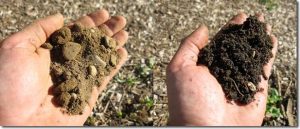I recently participated in a permaculture workshop, and one of the classes I attended was about how to build beautiful soil from hard ground. The teacher was passionate about her subject, and I couldn’t help reflecting on the similarities between her advice on soil with how we move.
The clay soil like what is found around my family’s farm in Montana is so hard you can’t hardly break it with a pick in summer, but as the master gardener explained, you can gradually convert that soil into permeable, oxygenated soil that’s truly alive and that supports diverse plantlife. In the same way, our bodies (and minds) may be stiff and unbending, but they can gradually regain freedom of movement.
I learned that the diversity of the soil is reflected in the biodiversity above the soil. If you want to grow plants, you need to feed the soil. For us human beings, our ideas, thoughts and beliefs are what define – and limit – our movement. Like soil biodiversity, the diversity of movement possibilities that we have reflects what’s beneath the surface: when we have fewer movement options, it is because we have less variety of options in our thinking about movement. If we believe that we can’t move in such-and-such a way, then our movement will reflect that belief, and if we believe that we can, our possibilities of movement will be very different.
The advice the gardening teacher gave us was to be curious! And not to impose a set of fixed ideas on the landscape – just because a certain technique works in one situation doesn’t mean it will work in others. She encouraged us to research and learn everything we can about different techniques, and then get out in the garden and just observe, be curious and experiment!
This is the same approach I take when I work with people in an Alexander Technique class. Rather than imposing a certain type of movement, I want to inspire their curiosity about how they organize themselves, how they move and how they think about movement. And what other possibilities might there be outside of what habit dictates? We begin to experiment, bringing attention to the head-spine relationship, to find these things out. That brings greater clarity. And like the soil that supports greater diversity and is therefore more resilient, this leads us to greater diversity of movement and postural options, and that makes us more resilient.
I hope this stimulates your curiosity about how you move and how you think about how you move. Through practicing the Alexander Technique, we can reconnect with our inherent capacity to move naturally. We can stop interfering with our natural design so that we can rediscover ease, flexibility and useful energy.
If you’d like to learn more, join the Mind-Body Freedom with Alexander Technique group on Facebook, join the mailing list to receive occasional articles or contact me at info@discoverease to take a workshop or private class.



Recent Comments